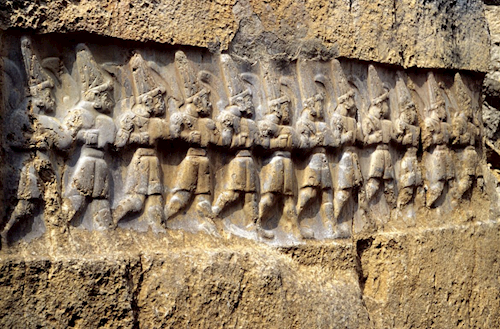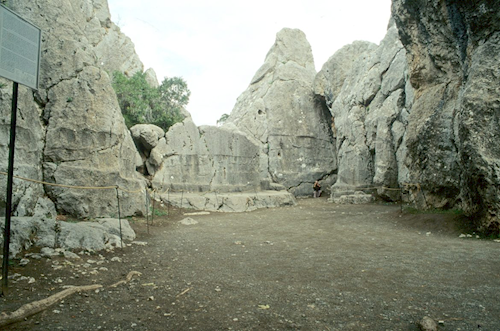
Original Link: https://wildhunt.org/2021/07/hittite-carving-may-reveal-insights-into-their-religion-and-cosmology.html
TWH – New research on a cut-rock relief reveals how ancient Hittite religion may have incorporated their view of the cosmos into their spiritual and ritual practices. The rock is part of the 3,200-year-old shrine at Yazılıkaya in modern-day Turkey. The shrine may have been created to embody how the universe was organized.
The research is presented in the June 2021 edition of the Journal of Skyscape Archeology. The findings are described as “a major scientific article about cosmic symbolism at the Hittite rock sanctuary Yazılıkaya near Hattusa.”
The shrine is in the Çorum Province of modern-day Turkey.
The Yazılıkaya sanctuary is an open-air space that is part of Hattusa the capital city of the Hittite Empire that dominated the central Anatolia subcontinent from the 11th to 15th centuries BCE. The empire eventually fell to the Middle Assyrian Empire and splintered further in the Late Bronze Age. The Hittites are attested in the book of Genesis of the Old Testament and described as a powerful civilization and allies of Abraham, the common patriarch of Judaism, Christianity, and Islam.
Despite its importance, it is not clear what the Hittites used the Yazılıkaya sanctuary for or even if they were its builders. It may have been used as a mausoleum or it may have been used to mark season changes.
Prior research conducted in 2019 by some of the same scientists involved in the current study, Eberhard Zangger and Rita Gautschy of the University of Basel, Switzerland, suggested that “the rock sanctuary of Yazılıkaya, which was considered one of the holiest places in the Hittite kingdom, had a calendrical function.” They suggested that Hittite priests, who were skilled observers of the sky, used the different chambers of the shrine to mark seasons.
One chamber called “Chamber A” shows a procession of 64 deities. One wall shows female deities wearing crowns and long skirts. The opposite wall shows male deities wearing traditional Hittite garments.

Relief of the twelve gods of the underworld at Yazılıkaya Temple, Turkey. [Photo Credit: Klau-Peter Simon. Wikimedia Commons CC BY 3.0]
The Hurrian goddess Šauška is shown in the male procession with two female attendants. Šauška, who researchers consider is equivalent to the Mesopotamian goddess Inanna, was adopted by the Hittites as their patron. She is a goddess of fertility, war, and healing. She is often depicted in human form with wings, standing with a lion and accompanied by two attendants.
The researchers noted that the reliefs found in “Chamber A,” are arranged in groups that appear to mark the days, synodic months, and solar years from which, priests were able to add additional months to keep the solar and lunar years aligned.
If confirmed, this processional calendar would be centuries ahead of its time, and that 2019 interpretation was met with skepticism.
The new research team which adds E.C. Krupp from the Griffith Observatory in Los Angeles and Serkan Demirel of Karadeniz Technical University, Trabzon, Turkey, extends their prior observations to suggest that the reliefs organize the cosmos and provide religious symbolism within Hittite culture and spiritual practices thus depicting the Hittite cosmology.
There is no evidence, one way or another, whether Hittites made their own observations of the heavens or borrowed them from their extensive contact with Mesopotamian cultures. They imported, for example, the cuneiform writing system and likely the culture as well. That cuneiform shows observation and calculations as well as predictions of celestial phenomena. So, in the process of incorporating, they may have also borrowed a synchronized religious calendar and an organization of the cosmos.
The researchers note that their new findings lend “additional support from the cosmological symbolism it seems to incorporate. The deities used for counting the days display a wide range of personalities, and we suggest that some of them symbolise stars or asterisms, perhaps along the path of the Moon, and other celestial bodies. We interpret the central panel with the supreme deities, at the far north end of Chamber A, as a reference to the northern stars, the north celestial pole, the circumpolar realm and the world axis. Chamber B, on the other hand, appears to have been intended to symbolise the netherworld.”
The interpretation suggests that the chambers convey astronomical as well as theological information.
The New Scientist reported, “They had a certain image of how creation happened,’ says Zangger. He says the Hittites imagined that the world began in chaos, which became organised into three levels: ‘the underworld, and then the earth on which we walk, and then the sky’.”

Yazilikaya – Hittite sanctuary near Hattusa [Photo Credit: Klau-Peter Simon. Wikimedia Commons CC BY 3.0]
The reliefs reflect the cyclical aspects of nature such as the processional waxing and waning of the moon that exposes the renewal -rebirth cycle within the Hittite cosmology.
Other researchers remain skeptical noting that the interpretation would be stronger if similar findings and evidence were identified at other Hittite sites.
Efrosyni Boutsikas at the University of Kent explained to New Scientist that the “team’s interpretations of the images aren’t based on Hittite texts, which say little about astronomy. Instead, the researchers have often used texts from Mesopotamian societies, which influenced the Hittites but were also distinct. She says the evidence would be stronger if similar links between gods and astronomy could be found at other Hittite sites.”
Still, Zangger and colleagues wrote, “Our interpretation of Yazılıkaya as a facility where the religious calendar was kept does not exclude previous interpretations of the site,” noting their findings support that Yazılıkaya was a central and sacred destination in Hittite religion and the site of the annual New Year’s spring (Itkalzi) festival.
This website is powered by Spruz